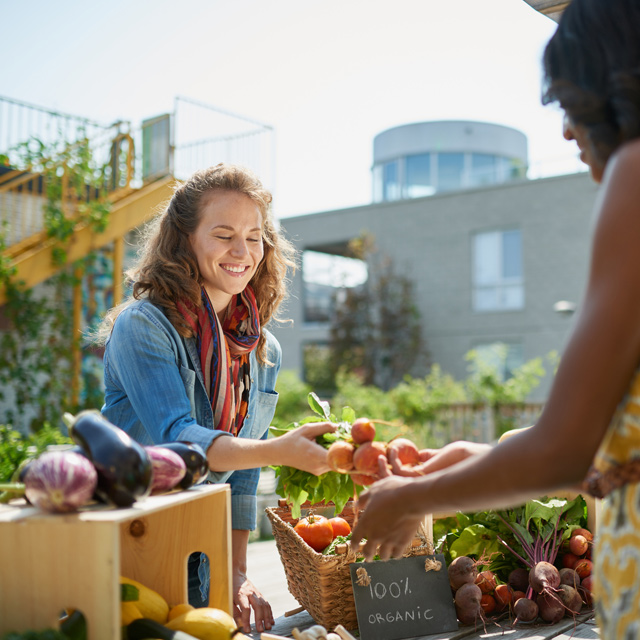Inside the Future of Urban Farmers Markets
Few things are as satisfying as scouting your local farmers market for the best carton of tomatoes you can find. Or treating yourself to a weekly apple-cider doughnut. Or chatting with the person who makes your favorite goat cheese. For many of us, urban farmers markets are one of the biggest perks of city living, in part because they offer connection with the land and with local growers—even in the middle of the urban jungle.
 There are close to 9,000 farmers markets all across the country.
There are close to 9,000 farmers markets all across the country.
Across the US, the number of markets has never been higher. Back in 1994, as CityLab notes, there were fewer than 2,000 farmers markets all over the country. Today? Close to 9,000, located in the city as well as in suburbs, exurbs, and rural areas. 35% of farm sales are now direct to consumers, whether through markets, CSA produce boxes, farm shops and roadside stands, and mobile markets. Farmers markets, it would appear, are here for the long haul.
New Market Tech and Developments
 Farmers markets are going digital—and making shopping for fresh produce easier than ever.
Farmers markets are going digital—and making shopping for fresh produce easier than ever.
As urban farmers markets continue to mature—evolving from exciting novelty to popular institution—technology designed to streamline the shopping experience has begun to flourish.
In our increasingly cashless world, portable card payment systems like Square have brought farmers markets into the digital age. Farmers are also turning to social media in order to build relationships with customers, highlight their appearances in the city, and provide a window into the farming life.
Beyond the markets themselves, a suite of related startups has also begun to crop up. WildKale, for instance, which currently operates on the East Coast, has created a digital market space: input your zip code to see the vendors, and their goods, available in your area. Choose what you want, and have it delivered to your door via UPS within the day. GrubMarket, headquartered on the West Coast, is another “farm to table delivery service” that has seen recent success.
Expanding to Different Communities
 Farmers markets are setting up shop in places with heavy foot traffic—and reaching more shoppers than ever before.
Farmers markets are setting up shop in places with heavy foot traffic—and reaching more shoppers than ever before.
While urban farmers markets have long been seen as a valuable tool for bringing neighbors together, they’ve also been viewed as exclusive—primarily the domain of the wealthy and privileged.
In an effort to reach new shoppers, farmers markets are growing into new communities, and are offering different services and perks to cater to local residents’ needs. Many markets are expanding to places with heavy foot traffic, like health centers and subway stations. Others aren’t just selling raw ingredients—they’re even assisting with food prep, to help appeal to busy, working households.
With the rise of digital payment processors like the Mobile Market+ app, hundreds of markets around the country also accept SNAP payments. Meanwhile, additional “programs rolling out across the nation are attracting new low-income customers by allowing them to extend the value of government assistance funds used on fresh food,” as CityLab notes.
Problems for Farmers Markets
 One problem? Lots of competition can mean lower sales (and a tricky situation for farmers).
One problem? Lots of competition can mean lower sales (and a tricky situation for farmers).
Despite the wide-ranging appeal that urban farmers markets offer, the format isn’t without its problems or difficulties. For one, market growth has actually slowed significantly in the last few years, leading some to question whether we’ve reached a peak.
With sluggish sales and plenty of competition, the format can also be difficult for the farmers themselves. As NPR notes, “farmers markets may be a good marketing tool for a small farm, but they can be onerous to prepare for, with slim profit margins.”
Then there’s SNAP. Following a convoluted series of budgeting and contracting issues, concerns arose this summer that farmers markets would no longer be able to process EBT cards. Though a temporary solution has been reached, the future of the program—which has been so key in expanding access to farm-fresh produce—still looks worryingly uncertain.
What You Can Do
 In order to ensure the health of your local market, make stopping by part of your weekly routine.
In order to ensure the health of your local market, make stopping by part of your weekly routine.
If you value your local farmers market, the simplest way to show your support is to keep coming back each week—and bring your roommates along with you, while you’re at it. Score super-fresh ingredients, meet your fellow neighbors, and don’t forget those apple cider doughnuts. Here’s a list of top-notch markets all across the country to get you inspired (and hungry).




